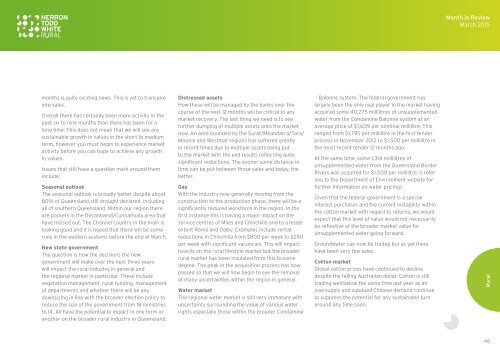Month-In-Review-March-2015
Month-In-Review-March-2015
Month-In-Review-March-2015
You also want an ePaper? Increase the reach of your titles
YUMPU automatically turns print PDFs into web optimized ePapers that Google loves.
<strong>Month</strong> in <strong>Review</strong><br />
<strong>March</strong> <strong>2015</strong><br />
months is quite exciting news. This is yet to transpire<br />
into sales.<br />
Overall there has certainly been more activity in the<br />
past six to nine months than there has been for a<br />
long time. This does not mean that we will see any<br />
sustainable growth in values in the short to medium<br />
term, however you must begin to experience market<br />
activity before you can hope to achieve any growth<br />
in values.<br />
Issues that still have a question mark around them<br />
include:<br />
Seasonal outlook<br />
The seasonal outlook is broadly better despite about<br />
80% of Queensland still drought declared, including<br />
all of southern Queensland. Within our region there<br />
are pockets in the Dirranbandi/Cunnamulla area that<br />
have missed out. The Channel country in the main is<br />
looking good and it is hoped that there will be some<br />
runs in the western systems before the end of <strong>March</strong>.<br />
New state government<br />
The question is how the decisions the new<br />
government will make over the next three years<br />
will impact the rural industry in general and<br />
the regional market in particular. These include<br />
vegetation management, rural funding, management<br />
of departments and whether there will be any<br />
downsizing in line with the broader election policy to<br />
reduce the size of the government from 18 ministries<br />
to 14. All have the potential to impact in one form or<br />
another on the broader rural industry in Queensland.<br />
Distressed assets<br />
How these will be managed by the banks over the<br />
course of the next 12 months will be critical to any<br />
market recovery. The last thing we need is to see<br />
further dumping of multiple assets onto the market<br />
now. An area bounded by the Surat/Meandarra/Tara/<br />
Moonie and Westmar regions has suffered greatly<br />
in recent times due to multiple assets being put<br />
to the market with the end results reflecting quite<br />
significant reductions. The sooner some distance in<br />
time can be put between those sales and today, the<br />
better.<br />
Gas<br />
With the industry now generally moving from the<br />
construction to the production phase, there will be a<br />
significantly reduced workforce in the region. <strong>In</strong> the<br />
first instance this is having a major impact on the<br />
service centres of Miles and Chinchilla and to a lesser<br />
extent Roma and Dalby. Examples include rental<br />
reductions in Chinchilla from $800 per week to $250<br />
per week with significant vacancies. This will impact<br />
heavily on the rural lifestyle market but the broader<br />
rural market has been insulated from this to some<br />
degree. The peak in the acquisition process has now<br />
passed so that we will now begin to see the removal<br />
of many uncertainties within the region in general.<br />
Water market<br />
The regional water market is still very immature with<br />
uncertainty surrounding the value of various water<br />
rights especially those within the broader Condamine<br />
- Balonne system. The federal government has<br />
largely been the only real player in the market having<br />
acquired some 40,275 millilitres of unsupplemented<br />
water from the Condamine Balonne system at an<br />
average price of $1,609 per nominal millilitre. This<br />
ranged from $1,795 per millilitre in the first tender<br />
process in November 2012 to $1,500 per millilitre in<br />
the most recent tender 12 months ago.<br />
At the same time, some 1,314 millilitres of<br />
unsupplemented water from the Queensland Border<br />
Rivers was acquired for $1,500 per millilitre. (I refer<br />
you to the Department of Environment website for<br />
further information on water pricing).<br />
Given that the federal government is a special<br />
interest purchaser and the current instability within<br />
the cotton market with regard to returns, we would<br />
expect that this level of value would not necessarily<br />
be reflective of the broader market value for<br />
unsupplemented water going forward.<br />
Groundwater can now be traded but as yet there<br />
have been very few sales.<br />
Cotton market<br />
Global cotton prices have continued to decline<br />
despite the falling Australian dollar. Cotton is still<br />
trading well below the same time last year as an<br />
oversupply and subdued Chinese demand continue<br />
to suppress the potential for any sustainable turn<br />
around any time soon.<br />
Rural<br />
46


